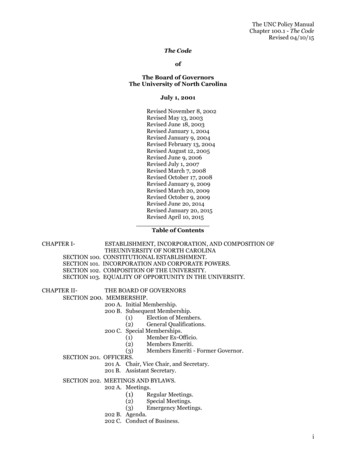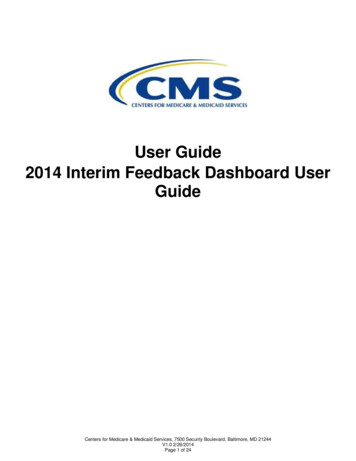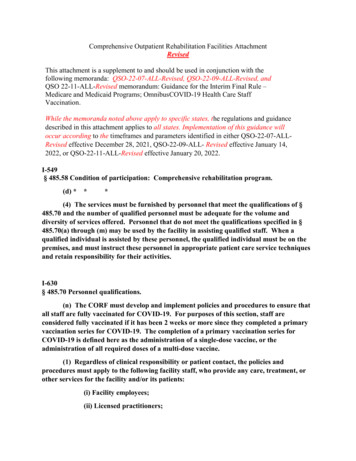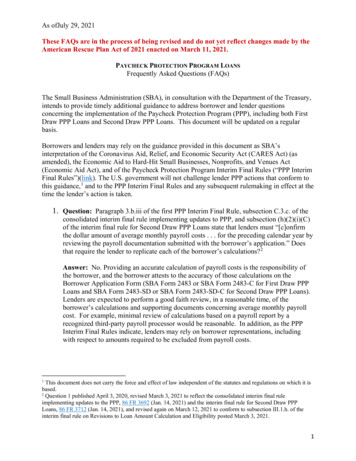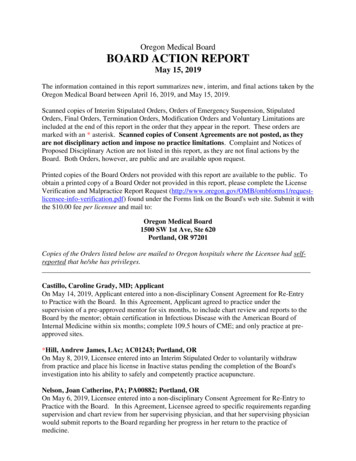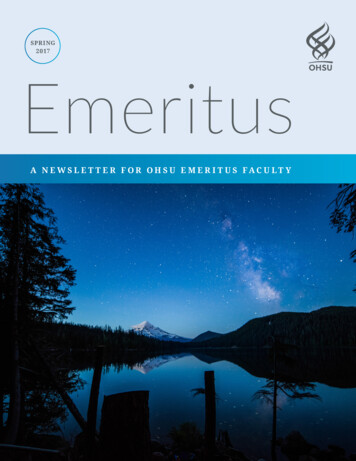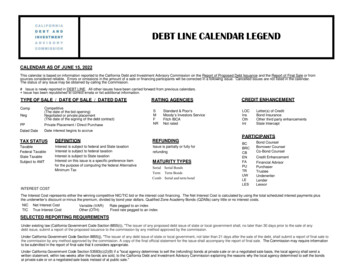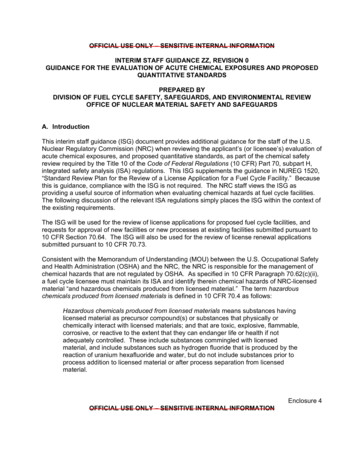
Transcription
OFFICIAL USE ONLY – SENSITIVE INTERNAL INFORMATIONINTERIM STAFF GUIDANCE ZZ, REVISION 0GUIDANCE FOR THE EVALUATION OF ACUTE CHEMICAL EXPOSURES AND PROPOSEDQUANTITATIVE STANDARDSPREPARED BYDIVISION OF FUEL CYCLE SAFETY, SAFEGUARDS, AND ENVIRONMENTAL REVIEWOFFICE OF NUCLEAR MATERIAL SAFETY AND SAFEGUARDSA. IntroductionThis interim staff guidance (ISG) document provides additional guidance for the staff of the U.S.Nuclear Regulatory Commission (NRC) when reviewing the applicant’s (or licensee’s) evaluation ofacute chemical exposures, and proposed quantitative standards, as part of the chemical safetyreview required by the Title 10 of the Code of Federal Regulations (10 CFR) Part 70, subpart H,integrated safety analysis (ISA) regulations. This ISG supplements the guidance in NUREG 1520,“Standard Review Plan for the Review of a License Application for a Fuel Cycle Facility.” Becausethis is guidance, compliance with the ISG is not required. The NRC staff views the ISG asproviding a useful source of information when evaluating chemical hazards at fuel cycle facilities.The following discussion of the relevant ISA regulations simply places the ISG within the context ofthe existing requirements.The ISG will be used for the review of license applications for proposed fuel cycle facilities, andrequests for approval of new facilities or new processes at existing facilities submitted pursuant to10 CFR Section 70.64. The ISG will also be used for the review of license renewal applicationssubmitted pursuant to 10 CFR 70.73.Consistent with the Memorandum of Understanding (MOU) between the U.S. Occupational Safetyand Health Administration (OSHA) and the NRC, the NRC is responsible for the management ofchemical hazards that are not regulated by OSHA. As specified in 10 CFR Paragraph 70.62(c)(ii),a fuel cycle licensee must maintain its ISA and identify therein chemical hazards of NRC-licensedmaterial “and hazardous chemicals produced from licensed material.” The term hazardouschemicals produced from licensed materials is defined in 10 CFR 70.4 as follows:Hazardous chemicals produced from licensed materials means substances havinglicensed material as precursor compound(s) or substances that physically orchemically interact with licensed materials; and that are toxic, explosive, flammable,corrosive, or reactive to the extent that they can endanger life or health if notadequately controlled. These include substances commingled with licensedmaterial, and include substances such as hydrogen fluoride that is produced by thereaction of uranium hexafluoride and water, but do not include substances prior toprocess addition to licensed material or after process separation from licensedmaterial.Enclosure 4OFFICIAL USE ONLY – SENSITIVE INTERNAL INFORMATION
OFFICIAL USE ONLY – SENSITIVE INTERNAL INFORMATIONAdditionally, as specified in 10 CFR 70.62(c)(iii), a fuel cycle licensee must identify in its ISA facilityhazards “that could affect the safety of licensed materials and thus present an increasedradiological risk.”For chemical hazards that are within the NRC’s jurisdiction, applicants and licensees must limit therisk of accidents involving such chemicals at their facilities. As stated in the 10 CFR 70.61(b)performance requirements, the risk of each “credible” high-consequence event must be limitedusing one of two methods. Controls (commonly referred to as items relied on for safety or IROFS)may be applied to the extent necessary to make the high-consequence event “highly unlikely” tooccur. Alternatively, IROFS may be applied to the extent necessary to make the consequences ofsuch events “less severe” than those described in 10 CFR 70.61(b)(1)-(4). Acute chemicalexposures that are deemed to be credible high-consequence events are specified in10 CFR 70.61(b)(4).A parallel set of performance requirements apply to “credible” intermediate-consequence events,the risk of which must be limited using one of two methods. As stated in 10 CFR 70.61(c), IROFSmay be applied to the extent necessary to make the intermediate-consequence event “unlikely” tooccur. Alternatively, IROFS may be applied to the extent necessary to make the consequences ofsuch events less than those described in 10 CFR 70.61(c)(1)-(4). Acute chemical exposures thatare deemed to be credible intermediate-consequence events are specified in 10 CFR 70.61(c)(4).Note that pursuant to 10 CFR 70.65(b)(9), ISA summaries are required to include an applicant’s orlicensee’s descriptions of its definitions of the terms “credible,” “highly unlikely,” and “unlikely,” asused in the ISA. An understanding of these definitions is important when reviewing an ISA’sassessment of a chemical accident’s likelihood. The reviewer should recognize the flexibility that10 CFR 70.65(b)(9) provides applicants and licensees, in that for any given facility, the ISAsummary will contain site-specific definitions of the above terms.In performing chemical safety reviews, the NRC staff reviewer needs to be familiar with therelevant ISA regulations that are summarized more fully below in Section C (Regulatory Basis).Section 70.4 of 10 CFR defines the term integrated safety analysis as a systematic analysis thatidentifies: (a) facility and external hazards; (b) the potential of these hazards to initiate accidentsequences; (c) what these potential accident sequences are, including their likelihood andconsequences; and (d) the items relied on for safety (IROFS). The definition further states that“integrated” means joint consideration of, and protection from, “all relevant hazards, includingradiological, nuclear criticality, fire, and chemical.” The phrase “all relevant hazards” is thus quitebroad, and covers all chemical exposure pathways as stated in Information Notice (IN) 2007-22“Recent Hydrogen Fluoride Exposures at Fuel Cycle Facilities”.As stated in 10 CFR 70.65(b)(7), an applicant or licensee must describe in its ISA Summaryproposed quantitative standards “used to assess the consequences to an individual from acutechemical exposure to licensed material or chemicals produced from licensed materials,” and thisprovision references the 10 CFR 70.61(b)(4) and (c)(4) performance requirements. This ISGprovides guidance to NRC reviewers evaluating these proposed standards and presents usefulinformation sources that the staff can refer to regarding these standards. Some of theseinformation sources have been published since NUREG-1520 was initially issued in 2002, and arerelevant for exposure pathways other than inhalation (e.g., dermal and ocular pathways).2OFFICIAL USE ONLY – SENSITIVE INTERNAL INFORMATION
OFFICIAL USE ONLY – SENSITIVE INTERNAL INFORMATIONAs indicated above, this ISG provides supplementary guidance to the NRC staff regarding thereview of an applicant’s or licensee’s chemical safety information, specifically focusing on thefollowing:(1)chemical hazards and accident sequences (topic covered in NUREG-1520,Section 6.5.2.2,“Chemical Hazard and Accident Sequences”);(2)chemical accident likelihood and consequences (topic covered in NUREG-1520, Section6.5.2.3, “Chemical Accident Likelihood and Consequences”); and(3)quantitative standards for chemical consequences (topic covered in NUREG-1520, Section3.4.3.2, “Integrated Safety Analysis Summary and Documentation,” Item (7).This ISG will be incorporated into a future revision of NUREG-1520.B. DiscussionB.1Review of Chemical Hazards and Accident SequencesThe staff reviewer should examine the method and information used by the applicant or licensee toidentify hazards and accident sequences that could result in acute chemical exposure to workersand individuals outside the controlled area. The method should be systematic and use informationabout the applicant’s material quantities, process, process equipment, and operations. Thereviewer should consider the results in light of historical experience at similar facilities andoperations.When reviewing chemical hazards, the staff should consider typical material properties such astoxicity, flammability, and reactivity. The reviewer should evaluate the applicant’s or licensee’sidentification of chemical hazards that could potentially produce “high” or “intermediate” acutechemical exposure events as described in 10 CFR 70.61(b)(4) and 70.61(c)(4). Table 1 of this ISGprovides information on the toxic or hazardous characteristics of some common fuel-cyclechemicals. The table references sources of publically-available information on toxic or hazardouscharacteristics of chemicals commonly present in fuel-cycle facilities, but does not contain anexhaustive list of chemicals that may be used at such facilities. Table 1 provides insight into thepotential severity of accidents involving the chemicals it references. In evaluating an applicant’s orlicensee’s identification of chemical hazards at its facility, the staff reviewer may need to examinethe information sources listed in Table 1 to find information for other chemicals of concern that maybe identified by the applicant or licensee. The reviewer should also verify that the Table 1information has not become outdated by new information on the toxic or hazardous characteristicsof relevant chemicals.The staff reviewer should recognize that accidents often occur (1) during non-routine operationsincluding maintenance where the hazards and controls are different from those of normaloperation, (2) as a result of unanalyzed plant modifications where new hazards might be3OFFICIAL USE ONLY – SENSITIVE INTERNAL INFORMATION
OFFICIAL USE ONLY – SENSITIVE INTERNAL INFORMATIONintroduced, and (3) as a result of operations being conducted outside of conditions examined inprevious safety analyses. (A general but useful reference is “What Went Wrong, Case Histories ofProcess Plant Disasters and How They Could Have Been Avoided,” by Trevor Kletz,IChemE/Butterworth-Heinemann, Oxford, England, 2009.) Any locations where hazardouslicensed material, including fissile material, could inadvertently be located should also beconsidered. A review of accident history in similar operations can be useful when evaluating thehazards present in a facility.B.2.Review of Chemical Accident ConsequencesThe estimation and classification of potential chemical exposure consequences generally involvesa multistep process, and the staff reviewer should examine how the licensee or applicant hasevaluated these potential consequences as discussed below. When reviewing chemical exposureconsequences, it is important to know whether the receptor is a worker inside the controlled area,or is an individual outside the controlled area. This is important because the high-consequenceand intermediate-consequence events described in the 10 CFR 70.61 performance requirementsare different, depending on whether the receptor is a worker or an individual outside the controlledarea.The first step involves assessing the material’s form and its concentration as it moves from therelease point to the receptor location, and the major physical processes involved in the initialrelease and subsequent transport. Estimating and classifying chemical exposure consequencesfurther involves an assessment of multiple parameters such as vessel size and pressure, hole size,building ventilation characteristics, building dimensions, and local meteorology. Methods forconducting these types of analyses are discussed in NUREG/CR-6410, “Nuclear Fuel CycleFacility Accident Analysis Handbook,” and the Center for Chemical Process Safety’s “Guidelinesfor Chemical Process Quantitative Risk Analysis,” published in 1999. The technical literature maypresent other methods that the staff reviewer might find useful. The reviewer should determine ifthe methods for estimating release rate and release conditions are reasonable (i.e., the results arenot clearly biased in a way that underestimates consequences) for the physical properties of thematerial being released.The second step involves determining the nature (e.g., inhalation, dermal) and the approximateduration of the chemical exposure. This estimate requires an understanding of the properties ofthe transported material (developed by the first step), an estimate of the effectiveness of anyprotective equipment, and of any actions of the exposed individual that would influence exposure(e.g., exposure time). The reviewer should determine if the methods the licensee or applicant usesfor estimating exposure are reasonable given factors such as the layout of the plant and thequalifications and training of the workers. In general, for chemical exposures via the inhalationpathway, it is reasonable to expect that both workers and individuals outside the controlled areamay be subject to such exposures. For chemical exposures via the dermal and ocular pathways, itis reasonable to expect that only workers would be subject to such exposures.The third step involves the assessment of the consequences from the exposure event. Thisevaluation requires an understanding of the estimated exposure (developed by the second step)and information on the toxic characteristics of the released material or its anticipated reaction4OFFICIAL USE ONLY – SENSITIVE INTERNAL INFORMATION
OFFICIAL USE ONLY – SENSITIVE INTERNAL INFORMATIONproducts. The same information on chemical toxic characteristics that is used to estimateconsequences is generally used to identify proposed standards as discussed in this document’sSection B.4.Estimation of accidental dermal and ocular exposure consequences for workers is generally morechallenging than estimating inhalation exposure consequences. Dermal and ocular exposure ofteninvolve liquids or aerosols (gas-liquid mixtures), and the estimation of exposure parameters—suchas exposure location on the receptor (e.g., hand vs. chest), the percent of body surface area, andthe duration of exposure may be difficult. Effects of dermal and ocular exposure often correlate tothe concentration of the material involved in the exposure (e.g., severe skin burns are associatedwith short exposure to nitric acid in concentrations greater than 20 percent). So in many cases itmay be more practical to estimate whether exposure is likely and, if it is, correlate exposure effectsto the concentration of the material involved in the exposure.The reviewer should examine the method(s) the licensee or applicant used to estimate exposure ofthe worker or the individual outside the controlled area. The reviewer should examine thereasonableness of any model used for the analysis and the specific parameters used in theanalysis.B.3Review of Chemical Accident LikelihoodThe staff reviewer should examine the methods the licensee or applicant used to estimate thelikelihood of an acute chemical exposure event. The reviewer should use the guidance inChapter 3 of NUREG-1520, “Integrated Safety Analysis and Integrated Safety Analysis Summary”when evaluating these methods.B.4Review of Proposed Quantitative Standards for Acute Chemical ExposureThe proposed quantitative standards serve to identify the event consequence categories for theISA’s chemical safety discussions. As stated in NUREG 1520, Section 6.5.2.3., the staff reviewerneeds to verify that the proposed quantitative standards used to assess consequences to anindividual from acute chemical exposures are acceptable.When reviewing proposed quantitative standards, the staff reviewer should consider specific eventsequences described in the ISA Summary. If the event sequence is determined to be highlyunlikely, no proposed quantitative standards are required. In a similar manner, if the eventsequence is determined to result in consequences that are less than the intermediate eventsdescribed in 10 CFR 70.61(c)(4), no proposed quantitative standards are required.B.4.1 General Criteria for Reviewing Proposed Quantitative StandardsThe proposed quantitative standards should be based on generally available information fromindependent sources (e.g., government agencies or organizations, well recognized professionalorganizations) describing the chemical’s toxicity and hazardous properties. The applicant’s orlicensee’s discussion of any proposed quantitative standard should describe the information onwhich the proposed standard is based. Due to the various information sources identified in this5OFFICIAL USE ONLY – SENSITIVE INTERNAL INFORMATION
OFFICIAL USE ONLY – SENSITIVE INTERNAL INFORMATIONISG, it is not expected that applicants will need to conduct their own experimental testing or toxicitytests to generate data supporting their proposed standards.Standards may have many forms. For inhalation exposures, the standard may be based on airconcentration for a given exposure time. For dermal exposures, the standard may be based onbody surface area (BSA) exposure for a given time. The staff should ensure that the proposedstandard is consistent with available toxicological information, and that the use of the proposedquantitative standard provides a reasonable estimate of event consequence (i.e. does not result inan underestimate of the event’s severity).The following sections provide specific examples of information sources that are acceptable to thestaff when evaluating an applicant’s proposed quantitative standards for classifying acute chemicalexposure events as high or intermediate.B.4.2 Reviewing Proposed Quantitative Standards for Air Exposure PathwayFor exposure scenarios where inhalation dominates the consequences, the staff has identifiedseveral useful information sources to evaluate an applicant’s proposed quantitative standards.Acceptable exposure standards include, but are not limited to, those based on the EmergencyResponse Planning Guidelines (ERPGs), the Acute Exposure Guidelines Levels (AEGLs),Temporary Emergency Exposure Levels (TEELs), the Globally Harmonized System ofClassification and Labelling of Chemicals (GHS), and the exposure limits established by OSHA orother Federal agencies and scientific organizations.As previously stated in NUREG 1520, the two most common data sources for the staff to use whenreviewing proposed quantitative standards for inhalation exposures are the AEGLs and ERPGs.The AEGLs1 are intended to describe the risk to humans resulting from once-in-a-lifetime, or rare,typically accidental exposure to airborne chemicals. The American Industrial Hygiene Association(AIHA) establishes the ERPGs 2. While these standards were developed for other purposes, suchas emergency guidelines for once in a lifetime exposures, the staff accepts the ERPG values todefine “high” and “intermediate” consequences in ISAs. These are inhalation exposure limits thatthe NRC staff has accepted previously as meeting the quantitative standards requirement stated in10 CFR 70.65(b)(7).Acceptable quantitative standards for classifying “high” consequence events would be exposure ofworkers to AEGL-3 or ERPG-3 levels. For individuals outside the controlled area, acceptablequantitative standards for classifying “high” consequence events would be exposure to AEGL-2 orERPG-3 levels. Acceptable quantitative standards for classifying “intermediate” consequenceevents would be exposure of workers to AEGL-2 or ERPG-2 levels. For individuals outside thecontrolled area, acceptable quantitative standards for classifying “intermediate” consequenceevents would be exposure to AEGL-1 or ERPG-1 levels.1The history and nature of AEGLs is discussed on an Environmental Protection Agency Web site:http://www.epa.gov/oppt/aegl/index.htm2ERPGs are discussed on an American Industrial Hygiene Association Web site: ts/ERPGIntroText.pdf6OFFICIAL USE ONLY – SENSITIVE INTERNAL INFORMATION
OFFICIAL USE ONLY – SENSITIVE INTERNAL INFORMATIONAs stated above, another data source the staff can use when reviewing proposed quantitativestandards for inhalation exposures are the TEELs, commissioned by the U.S. Department ofEnergy (DOE). TEELs are temporary and alternative guidelines used for chemicals that do nothave established ERPGs and AEGLs values3. Acceptable quantitative standards for classifying“high” consequence events would be exposure of workers to TEEL-3 levels, and exposure toindividuals outside the controlled area to TEEL-2 levels. Acceptable quantitative standards forclassifying of “intermediate” consequence events would be exposure of workers to TEEL-2 levels,and exposure to individuals outside the controlled area to TEEL-1 levels.A fourth acceptable data source which can be used in staff’s evaluation of proposed quantitativestandards for inhalation exposures is the database on which the GHS is based. The GHS is aninternationally standardized system for characterizing and labeling chemical hazards to helpprotect consumers, workers, transportation workers, and emergency responders. The GHSdefines different types of hazards (physical hazards, health hazards, environmental hazards) andestablishes methods for assigning standardized GHS hazard statements used to communicateinformation about the severity of the hazard for specific exposure routes4. OSHA’s HazardCommunication Standard has been aligned with the GHS to improve the quality and consistency ofhazard information in the workplace.5Several databases present hazardous property information including: European Chemical Agency Classification and Labelling Inventory Database. GESTIS database on hazardous substances.The staff may also use the information available in the GHS database when evaluating a proposedstandard. Table 1 provides GHS hazard statements for common chemicals in the fuel cycleprocess. The GHS hazard statements specific for the inhalation exposure pathway that can beused to support proposed quantitative standards are H330 (fatal if inhaled), H331 (toxic if inhaled),and H332 (harmful if inhaled). Acceptable proposed quantitative standards for classifying “high”consequence events would be exposure of workers to a chemical that has a hazard statement ofH330 and exposure to individuals outside the controlled area to a chemical that has a hazardstatement of H331. Acceptable quantitative standards for classifying of “intermediate”consequence events would be exposure of workers to a chemical that has a hazard statement ofH331 and exposure to individuals outside the controlled area to a chemical that has a hazardstatement of H332. The staff review of the derivation of the proposed standard should also involvea general review of the literature to confirm that the information in the GHS database is consistentwith the general literature.Table 2 presents the descriptions from the various information sources (i.e. AEGLs, ERPGs andGHS) and compares it to the descriptions of “high” and “intermediate” consequence chemicalexposure events specified in 10 CFR 70.61(b)(4) and (c)(4). The hazard statements in the GHS345TEELs are discussed in a DOE Handbook DOE-HDBK-1046: 6-2008 ac.pdfGlobally Harmonized System of Classification and Labelling of Chemicals (GHS), fifth revised edition, 2013, Part 3 Health HazardsOccupational Safety and Health Administration, Final Rule on Hazard Communication, Federal Register, Vol. 77, No. 58, March 26,2012, pp. 17574-17896.7OFFICIAL USE ONLY – SENSITIVE INTERNAL INFORMATION
OFFICIAL USE ONLY – SENSITIVE INTERNAL INFORMATIONdatabase are considered useful when reviewing proposed standards, particularly when AEGLs,ERPGs, or TEELs are not available.B.4.3 Reviewing Proposed Standards for the Dermal Exposure PathwayStaff has accepted the National Institute for Occupational Safety and Health (NIOSH) SkinNotations, and the GHS hazards statements as useful data on which an applicant may base itsproposed quantitative standards for dermal and ocular exposures. The reviewer needs to verifythat an applicant’s proposed dermal standards are consistent with available and technically soundinformation or well established data sources. If the applicant proposes other sources ofinformation as the basis for a proposed standard, the reviewer should evaluate the adequacy ofthe information the applicant is using.The NIOSH Skin Notations involve the assignment of multiple skin notations for distinguishingsystemic (SYS), direct (DIR), and sensitizing (SEN) effects caused by exposure of skin (SK) tochemicals. These skin notations use standardized terms including: (1) the system label/subnotation SYS (FATAL), which indicates a chemical is highly or extremely toxic, and may bepotentially lethal or life-threatening following skin exposures; (2) the direct label/sub-notation DIR(IRR) indicates that a chemical is a skin irritant and; (3) DIR (COR) identifies the chemical as acorrosive agent.6 The FATAL subnotation is applied if the median lethal dose (LD50) values areconsistently lower than the critical cutoff value of 200 mg/kg of animal body weight. The IRR subnotation is assigned when the data indicate that exposure of the skin causes reversible effects.The COR sub-notation is used when exposure to the chemical causes irreversible adverseeffects.7For chemicals that have a NIOSH skin notation of SYS (FATAL) for dermal exposure, staff hasaccepted the SYS notation as a proposed standard with “high” consequences to workers.Additionally, the applicant may consider establishing the proposed standard based on the LD50data that may be stated on the skin notation profile. For chemicals that have a NIOSH skinnotation of DIR (COR) for dermal exposure, staff has accepted the DIR notation as a proposedstandard with “intermediate” consequences to workers. For chemicals that have a NIOSH skinnotation of DIR (IRR), the staff has accepted this notation as a proposed standard of “less thanintermediate.”The databases supporting the GHS statements discussed earlier are another source of usefulinformation which can be used to support dermal exposures standards. The GHS database useshazard statements for two hazard classes: acute toxicity, and skin corrosion/irritation.6NIOSH skin notations are discussed on a NIOSH Web ation profiles.html7“A Strategy for Assigning New NIOSH Skin Notations” (National Institute for Occupational Safety and Health), Current Intelligence,Bulletin 61, July 2009. This document notes that the NIOSH skin notation strategy is consistent with the classification strategy beingused by the UN GHS efforts.8OFFICIAL USE ONLY – SENSITIVE INTERNAL INFORMATION
OFFICIAL USE ONLY – SENSITIVE INTERNAL INFORMATIONAcceptable proposed quantitative standards for classifying “high” consequence events would beexposure of workers to a chemical that has a hazard statement of H310 (fatal in contact with skin).Acceptable quantitative standards for classifying of “intermediate” consequence events would beexposure of workers to a chemical that has a hazard statement of H311 (toxic in contact with skin)and H314 (causes severe skin burns and eye damage). The staff will generally consider dermalexposure to a chemical with the GHS hazard statements of H312 (harmful in contact with skin),H313 (may be harmful in contact with skin), H315 (causes skin irritation), H316 (causes mild skinirritation), and H317 (may cause an allergic skin reaction) as being associated with less than“intermediate” worker exposure events.Dermal exposure effects would generally be considered to be minimal if (1) the chemical is notlisted in Table A-1 of OSHA’s Technical Manual, Section II, Chapter 2 “Surface Contaminants, SkinExposure, Biological Monitoring and Other Analyses”; or (2) the chemical does not have a NIOSHSkin Notation of SYS or DIR notations; or (3) the chemical does not have a GHS hazard statementof H310, H311, H312, H313 or H314.Table 3 below lists these information sources for the dermal pathway, and includes language inthese information sources which describes specific effects. Table 3 also compares thesedescriptions of specific effects with the consequence severity language used in 10 CFR 70.61.The table focuses on workers because dermal exposure of individuals outside the controlled areais generally expected to be highly unlikely or not credible.B.4.4 Reviewing Proposed Standards for the Ocular Exposure PathwayThe databases supporting the GHS discussed earlier are generally applicable sources of usefulinformation for ocular exposure standards. The reviewer needs to verify that an applicant’sproposed ocular standards are consistent with available and technically sound information or wellestablished data sources. If the applicant proposes other sources of information as the basis for aproposed ocular standard, the reviewer should evaluate the adequacy of the information theapplicant is using.Acceptable proposed quantitative standards for classifying “intermediate” consequence eventswould be exposure of workers to a chemical that has a hazard statement of H318 (causes seriouseye damage). The staff will generally consider ocular exposure to a chemical with the GHS hazardstatements of H319 (causes serious eye irritation) and H320 (causes eye irritation) as beingassociated with less than “intermediate” worker exposure events.Table 4 lists these information sources for the ocular exposure pathway, and includes language inthese information sources which describes specific effects. Table 4 also compares thesedescriptions of specific effects with the consequence severity language used in 10 CFR 70.61.The table focuses on workers based on the assumption that ocular exposure of individuals outsidethe controlled area is generally expected to be highly unlikely or not credible.The Section B.4 discussion above illustrates the potential need to consider a broad range ofinformation sources when reviewing licensee or applicant-proposed quantitative standards.9OFFICIAL USE ONLY – SENSITIVE INTERNAL INFORMATION
OFFICIAL USE ONLY – SENSITIVE INTERNAL INFORMATIONRegulatory BasisThe bases for this ISG are the requirements i
review of an applicant's or licensee's chemical safety information, specifically focusing on the following: (1) chemical hazards and accident sequences (topic covered in NUREG-1520,Section 6.5.2.2, "Chemical Hazard and Accident Sequences"); (2) chemical accident likelihood and consequences (topic covered in NUREG-1520, Section
